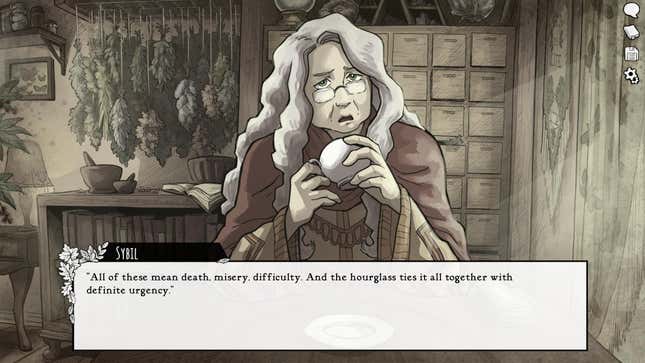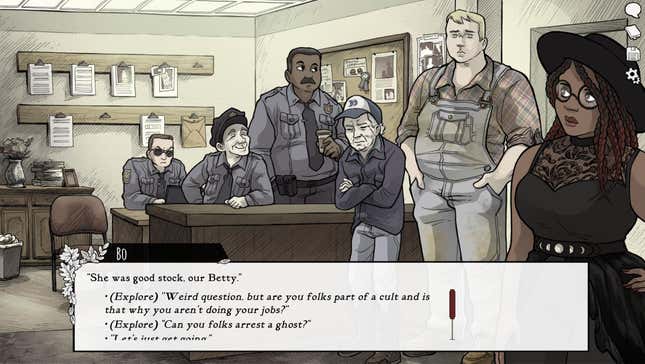
I am so beyond delighted to report that Scarlet Hollow, one of my favorite games of the last couple of years, continues to somehow get better and better. Episode 4 is out now and is by far the largest, most elaborate, most choice-filled part so far. And this time out the story gets meaty.

Buried Treasure
Buried Treasure is a site that hunts for excellent unknown games that aren’t getting noticed elsewhere. You can support the project via its Patreon.
To catch everyone up: Scarlet Hollow began in 2020, when the first chapter (which is now free) of the spooky tale was released. Out of the gate, it demonstrated some extraordinary narrative ballet. You play a character heading to the small Southern town of Scarlet Hollow, following the death of your aunt, ostensibly to attend her funeral. On arrival, you meet your furious cousin Tabitha with whom you’re staying, and then a group of other local 20-somethings whom you befriend. You’re quickly dragged into misadventures involving disturbing creatures in the woods, suspiciously-acting locals, and a foreboding sense that something is very wrong in town. (Read my original review to find out more.)

From the opening moments when you choose who you are and two of seven defining character traits, you are uniquely carving out a path through everything that’s to come. Maybe you’re preternaturally attractive, or perhaps incredibly book smart. You could get yourself the extra perception of a keen eye, or...the ability to talk to animals. Each dramatically affects how you experience the story to come. And from the start, you begin deciding how you want to interact at any given moment, allowing you to be told its creepy tale of woodland horrors and impending doom defined by the relationships you form, the places you visit, and the people you betray.
I’ve played so many games over the years that have promised the above, and so very few have delivered. But Scarlet Hollow is an exemplar, a game that truly understands that the trick is not to try to write an infinite number of story paths but rather to allow the player to experience its core story path in a unique way. And Chapter 4 goes so much further with this, not only carrying over all your decisions and relationships from the previous three episodes but based on those, allowing you to make enormously important decisions about how things will progress.

You’ll note I’m being deliberately ambiguous here because reviewing a game halfway through its planned seven chapters is not an easy task. Literally everything is a spoiler at this point, not only in the sense of opening a book midway through and starting to read, but even acknowledging the characters who are still around. People have lived and died based on my actions.
Instead, I’ll talk more broadly. In this latest and largest chapter, with many friendships formed or lost, and the core elements of the story already laid out, it’s able to let stuff really get rolling. Chapter 4 is where the game leans much harder into its horror, yet is the first time you’ll be able to engage in any of the five possible romance options. Which is a pleasing contrast.
While you’ve only been in town for four days, a lot has happened to you and your group of friends. An awful lot if you made one particular, game-changing decision at the end of Chapter 3. So being able to tell the character of your choice that you’re into them doesn’t feel rushed or forced—and indeed, you’re perfectly welcome not to say any such thing to anyone. The horror, meanwhile, is also surprisingly variable, given how you choose to approach things.
I’m loath to deliberately see multiple paths, preferring to just play through for the sake of preserving my own experience, but for the sake of reviewing, I obviously had to check out if other options really were as divergent as they appeared, or if they were bluffs that would steer back to the same course. They weren’t bluffs. One side path I took with a safe save beforehand saw the most incredibly grisly events take place, and I can’t even imagine where the story would go following them. Replaying the whole chapter, but changing how I ended Chapter 3, saw even more changes. It’s ultimately the same game, the same scenes in a similar order, but it’s how you perceive them that so dramatically alters.

For a game that’s played by making narrative choices, Chapter 4 achieves something incredible: a sense of urgent, panicked danger. Despite being able to click through the dialogues at my own pace, I found myself frantically speeding up at points, chased as I was, desperately looking for a route to safety! In other places, depending on how you ended the previous chapter, the game limits your choices, reversing this feeling and making me wish I could somehow slow things down to not miss out on any element.
I’m so obsessed with how intricately Scarlet Hollow crafts its narrative that I could forget to talk about its art. But this continues to be stunning, every scene hand-drawn, and while it doesn’t boast the remarkable animated dream art of Chapter 3, it’s far more detailed, displaying stunning drawings for scenes barely glimpsed at once as you play. That the small team behind this project is able to get more ambitious with every chapter is incredible.
I feel like Scarlet Hollow is a demonstration of how the format for the visual novel is just a foundation on which so much greater can be built. While the screenshots may look like a standard VN, the game itself is vastly more, not just with its RPG-like systems and ridiculously complex balancing of choices, but the far greater sense of scale, time, and significance. I’ve been blown away by it all over again.
You can get Scarlet Hollow’s first four chapters from Steam right now.
This article originally appeared on Buried Treasure. You can support the Patreon here.




